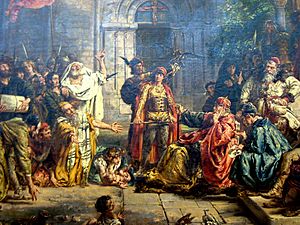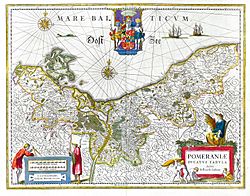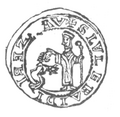Bolesław III Wrymouth facts for kids
Quick facts for kids Bolesław III Wrymouth |
|
|---|---|
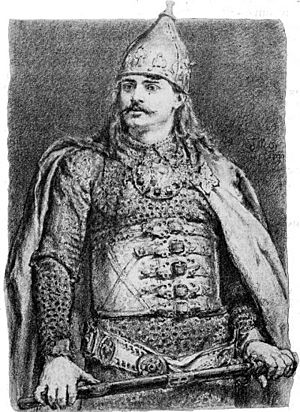 |
|
| Duke of Poland | |
| Reign | 1107–38 |
| Predecessor | Władysław I Herman |
| Successor | Władysław II the Exile |
| Born | 20 August 1086 Płock, Poland |
| Died | 28 October 1138 (aged 52) Sochaczew, Poland |
| Burial | Masovian Blessed Virgin Mary Cathedral, Płock, Poland |
| Wives |
|
| Issue more... |
|
| House | Piast |
| Father | Władysław I Herman |
| Mother | Judith of Bohemia |
| Religion | Roman Catholic |
Bolesław III Wrymouth (born August 20, 1086 – died October 28, 1138) was an important duke who ruled over all of Poland from 1107 to 1138. He was the only son of Duke Władysław I Herman and his first wife, Judith of Bohemia.
Bolesław started ruling when Poland's central government was weak. His father, Duke Władysław I Herman, was heavily influenced by a powerful official named Sieciech. Bolesław and his half-brother Zbigniew worked together to remove Sieciech from power in 1101. After their father died in 1102, Bolesław and Zbigniew each ruled a part of Poland.
Bolesław wanted to control Pomerania, a region to the north. This led to a fight with Zbigniew, who then fled Poland and sought help from King Henry V of Germany. Bolesław eventually had Zbigniew blinded. This act upset many people in Poland. To regain their trust, Bolesław showed public regret and went on a pilgrimage to a monastery in Hungary.
Bolesław worked to keep good relationships with neighboring Hungary and Kievan Rus. He made alliances through marriages and military help. This helped Poland stay strong and independent from Germany and Bohemia. These alliances also helped Bolesław defend Poland from an invasion in 1109. Later, he used problems within Bohemia to keep peace on Poland's southern border.
Bolesław spent the second half of his rule conquering Pomerania. He took control of northern cities along the Noteć river, making Poland's border stronger. He continued to expand, eventually bringing Western Pomerania and Gdańsk Pomerania under Polish control. After these conquests, Bolesław helped build churches and started converting the people of Pomerania to Christianity. Bishop Otto of Bamberg played a key role in this effort.
In the 1130s, Bolesław got involved in a conflict in Hungary. After a defeat, he had to make a deal with Germany. At a meeting in Merseburg in 1135, they discussed the future of Pomerania and the Polish Church. Bolesław's most important act was his will, known as "The Succession Statute." In this will, he divided Poland among his sons. This led to nearly 200 years of Poland being split into smaller parts.
Bolesław III Wrymouth is remembered as a symbol of Poland's desire for independence. He also protected the independence of the Polish Church. Even though he made some mistakes, like his actions against his half-brother Zbigniew, Bolesław was a very ambitious ruler who could also find ways to compromise.
Contents
Bolesław's Early Life
His Birth and Name
Bolesław was born on August 20, 1086, in Płock, Poland. His parents were Duke Władysław I Herman and Duchess Judith of Bohemia. His parents had prayed for a son, and Bolesław was their answer.
He was named Bolesław after his famous uncle, Bolesław II the Bold. This was likely a way to please his uncle's former supporters. Bolesław's nickname, "Wrymouth" (Krzywousty in Polish), appeared in writings about 100 years after his death. It probably referred to a physical feature, perhaps a slightly crooked mouth. Some historians believe it might have been due to an old injury.
Early Challenges in Poland
When Bolesław was born, his father, Duke Władysław I Herman, faced many challenges. A powerful noble named Sieciech had gained a lot of control over the country. Sieciech made many enemies among the Polish nobles.
Bolesław's older half-brother, Zbigniew, was sent away to a monastery. This was likely to prevent him from claiming the throne. However, Sieciech's enemies brought Zbigniew back to Poland. This led to a civil war.
During this time, many people left Poland because of Sieciech's harsh rule. Interestingly, around 1096, many Jews started moving to Poland from Western Europe. Duke Władysław I Herman welcomed them, as he believed they would help Poland's economy grow.
Youth and Power Struggles
Dividing the Country
As Bolesław grew older, he and Zbigniew united against Sieciech. Even though Bolesław was only 12, he was part of the plan to remove Sieciech. The brothers demanded that their father, Duke Władysław I Herman, share power.
Their father agreed to divide the country. Each brother would rule his own region. Władysław I Herman kept control of Mazovia and some important cities. Zbigniew received northern Poland, including Greater Poland. Bolesław received southern Poland, including Lesser Poland and Silesia.
Fighting Sieciech
Sieciech was worried about this division of power. He started preparing for war against the brothers. Bolesław and Zbigniew formed an alliance to fight Sieciech. In 1099, their armies defeated Sieciech's forces. Duke Władysław I Herman was then forced to remove Sieciech from his powerful position.
Sieciech fled, but later returned to Poland. However, he never regained his political power. Some sources suggest he may have been blinded.
Bolesław Becomes Sole Ruler
Struggle for Control (1102–1106)
Duke Władysław I Herman died in 1102. Poland was then split into two separate states, one ruled by Bolesław and the other by Zbigniew. Bolesław, who was only 16, wanted to expand his territory into Pomerania. Zbigniew, however, wanted to keep peace with Pomerania.
Bolesław launched raids into Pomerania. This angered Zbigniew, whose lands were being attacked in retaliation. Zbigniew allied with Bohemia against Bolesław. Bolesław, in turn, allied with Kievan Rus' and Hungary. In 1103, Bolesław married Zbyslava of Kiev, the daughter of a Kievan prince, to strengthen this alliance.
The conflict between the brothers continued. Bolesław made military expeditions into Pomerania and Bohemia. Eventually, in 1106, Bolesław attacked Zbigniew's territory with the help of his Kievan and Hungarian allies. Bolesław's forces quickly took control of many important cities. A peace treaty was signed, and Zbigniew officially recognized Bolesław as the Supreme Prince of all Poland. Zbigniew was allowed to keep Mazovia as a smaller territory.
Bolesław Takes Full Power
In 1107, Bolesław, with his allies, invaded Bohemia to help a new duke take the throne. This was a success.
Later that year, Bolesław launched another attack against Zbigniew. Zbigniew had not followed Bolesław's orders and had failed to provide military help. Bolesław's forces quickly defeated Zbigniew, who was then banished from Poland. Zbigniew fled to Bohemia. From this point on, Bolesław was the sole ruler of Poland.
War with Germany (1109)
In 1109, Emperor Henry V of Germany, with help from Bohemia, invaded Poland. He claimed he wanted to restore Zbigniew to power. Henry V demanded that Bolesław give Zbigniew half of Poland, recognize Henry as his overlord, and pay a large tribute. Bolesław refused.
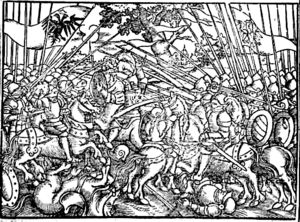
The fighting mainly took place in Silesia. Henry V's army besieged major cities like Głogów and Wrocław. Bolesław defended the cities and also used guerrilla tactics against the invaders. He is said to have defeated the German forces at the Battle of Hundsfeld on August 24, 1109, though some historians question if this battle truly happened.
Zbigniew's Fate
In 1111, a truce was signed between Poland and Germany. This allowed Zbigniew to return to Poland. However, Zbigniew soon tried to claim more power, which Bolesław saw as an act of betrayal. In 1112, Bolesław ordered Zbigniew to be blinded. This was a very harsh punishment and caused a strong negative reaction among the Polish people.
Bolesław's Penance
Many believed that Archbishop Martin I of Gniezno excommunicated Bolesław for blinding his half-brother. This meant Bolesław's subjects were no longer bound by their oaths to him. To regain trust and authority, Bolesław showed deep regret. He fasted, gave gifts to the poor, and made a pilgrimage to the Abbey of Saint Giles in Somogyvár, Hungary. He also sought forgiveness from Zbigniew. After these acts of penance, the excommunication was lifted.
Zbigniew likely died shortly after, possibly in 1113, as a monk in a monastery.
Conquering Pomerania
Securing Borders
Bolesław spent much of his rule focused on taking back Pomerania, which had been lost by earlier Polish rulers. His goals were to strengthen Poland's northern border and make Pomerania a Polish territory. By 1113, he had fortified cities along the Noteć river.
In 1114, Bolesław made peace with Bohemia. This was sealed by his marriage to Salomea of Berg, a German noblewoman. This peace allowed him to focus on his northern campaigns.
Taking Gdańsk Pomerania
After securing peace with Bohemia, Bolesław successfully attacked Prussia in 1115. This protected Poland's northeastern border. Then, from 1115 to 1119, he conquered Gdańsk Pomerania. This brought the lands along the Vistula River fully back into Poland. Polish nobles replaced local rulers, and Polish church organization was introduced.
During these campaigns, a rebellion led by Count Palatine Skarbimir began. Bolesław quickly put down the rebellion in 1117, and Skarbimir was also blinded as punishment. This conflict showed Bolesław's determination to maintain his power.
Conquering Western Pomerania
In 1121, Bolesław's army defeated the Pomeranian dukes at the battle of Niekładź. Polish troops then moved into Pomerania, destroying cities and forcing people to move deeper into Polish territory. Bolesław then attacked Szczecin (1121–1122), a well-defended city. He surprised the defenders by attacking across a frozen swamp and took control of the city. Many people were killed, and the survivors had to pay tribute to Bolesław.
By 1122, Bolesław had fully conquered Western Pomerania, which became a territory under Polish control. Duke Wartislaw I of Pomerania had to pay tribute to Bolesław and provide military help.
Bringing Christianity to Pomerania
To strengthen his control over Pomerania, Bolesław organized missions to convert the people to Christianity. He wanted Pomerania to be part of the Polish Church. After some failed attempts, Bishop Otto of Bamberg led two successful missions in 1124–1125 and 1128.
Bishop Otto worked closely with Duke Wartislaw I. They traveled through Pomerania, converting people and building churches where pagan temples once stood. The conversion faced some resistance, especially in important pagan centers like Szczecin and Wolin. Bolesław helped by lowering the annual tribute on the Pomeranians. The Christianization of Pomerania was one of Bolesław's greatest achievements.
The Congress of Merseburg
In 1125, Emperor Henry V of Germany died. His successor, Lothair III, faced his own challenges. Bolesław had expanded Poland's influence, even taking control of the island of Rügen. Germany wanted these lands, but its internal problems prevented a direct conflict.
Bolesław also got involved in a civil war in Hungary. He supported one claimant, Boris, but underestimated the strength of Boris's rival, Béla the Blind. In 1132, Bolesław's army was defeated by a combined force from Hungary, Bohemia, Austria, and Germany.
This defeat weakened Bolesław's position. Bohemia, a German ally, repeatedly invaded Silesia. Also, a papal order in 1133 gave the Archbishopric of Magdeburg control over the new Pomeranian churches, which Bolesław had wanted for the Polish Church.
Meeting with the Emperor
Because of these challenges, Bolesław was forced to meet with Emperor Lothair III. The meeting took place on August 15, 1135, in Merseburg. At this meeting, Emperor Lothair III recognized Bolesław's control over Pomerania and the island of Rügen. In return, Bolesław agreed to pay tribute for these lands to the Holy Roman Empire. However, Bolesław remained fully independent as the ruler of Poland itself.
The conflict with Hungary also ended, with Bolesław recognizing Béla II's rule. The meeting ended with church ceremonies, where Bolesław was given the honor of carrying the imperial sword, a sign of a sovereign ruler. This meeting also helped to confirm the independence of the Polish Church.
Last Years and Death
Peace with Neighbors
After the Merseburg meeting, Poland made peace with Bohemia in 1137. Bolesław also arranged marriages for his children to strengthen ties with neighboring countries. In 1137, his son Bolesław IV the Curly married a princess from Kievan Rus'. In 1138, his son Mieszko III the Old married a Hungarian princess, Elizabeth, daughter of King Béla II of Hungary.
Bolesław's Death and Will
Bolesław III Wrymouth died on October 28, 1138, likely in Sochaczew. He was buried in the Masovian Blessed Virgin Mary Cathedral in Płock.
Before his death, Bolesław created a will, known as the "Statute of Succession." He divided Poland among his sons to prevent future power struggles. This will introduced the "senioral principle," meaning the oldest member of the ruling family would have supreme power and control a special "seniorate province" in the middle of Poland, with Kraków as its capital. The senior duke would also control Pomerania.
Bolesław divided his lands into several provinces:
- Władysław II the Exile (the eldest son) received Silesia. He became the first senior duke.
- Bolesław IV the Curly received Masovia.
- Mieszko III the Old received Greater Poland.
- Henry received Sandomierz.
- Bolesław's widow, Salomea of Berg, received Łęczyca as her own territory.
His youngest son, Casimir II the Just, was not included in the will because he was born after his father's death or shortly before.
Unfortunately, the "senioral principle" did not work as Bolesław intended. It was soon broken, leading to nearly 200 years of Poland being divided into smaller, independent duchies. This period, known as feudal fragmentation, caused internal conflicts but also led to growth in culture and local development.
Family
First Marriage
Bolesław's first wife was Zbyslava of Kiev (died around 1114). She was a princess from Kievan Rus'. Their marriage in 1103 helped Bolesław gain military support against his half-brother Zbigniew. They had one known son:
- Władysław II the Exile (born 1105 – died 1159), who became Prince of Kraków and Silesia.
Second Marriage
After Zbyslava's death, Bolesław married Salomea of Berg (born around 1093/1101 – died 1144) in 1115. She was a German noblewoman. This marriage helped create peace between Poland and Bohemia. They had many children:
- Leszek (born 1115/16 – died before 1131), who likely died as a baby.
- Ryksa (born 1116 – died after 1156), who married Danish and Swedish princes.
- A daughter (born before 1117/22 – died after 1131).
- Casimir (born 1122 – died 1131), who died young.
- Gertruda (born 1123/24 – died 1160), who became a nun.
- Bolesław IV the Curly (born around 1125 – died 1173), who became Prince of Masovia and Kraków.
- Mieszko III the Old (born 1126/27 – died 1202), who became Duke of Greater Poland and Kraków.
- Dobroniega Ludgarda (born 1129 – died by 1160).
- Judith (born 1130 – died 1175), who married a German margrave.
- Henry (born 1131 – died 1166), who became Duke of Sandomierz.
- Agnes (born 1137 – died after 1182), who married a Kievan prince.
- Casimir II the Just (born 1138 – died 1194), who became Duke of Wiślica and Kraków.
Images for kids
See also
 In Spanish: Boleslao III de Polonia para niños
In Spanish: Boleslao III de Polonia para niños


